Pekingese Breed Guide
This breed is over 2,000 years old and has changed little over the centuries. Affectionately known as a Peke, these tiny bundles of fur originated in China, where they were favorites in the Imperial Court. In fact, another name for the Pekingese is the Fu Dog, with Fu representing the Chinese word for happy. The Peke’s ancestry is intertwined with that of the Tibetan Spaniel, the Japanese Chin, the Papillon, the Long-haired Chihuahua, the Shih Tzu, and the Pug.
How did the Pekingese breed originate?
Although the actual origins of the Pekingese are somewhat cloudy because it is so ancient, there are three charming legends surrounding the origins of the breed. In the first, a lion fell in love with a marmoset, but the lion was much too large. He asked Buddha to shrink him to the size of the marmoset. The tiny lion was the first Pekingese.
In the second legend, the lion fell in love with a butterfly. They both went to Buddha to ask him to equalize their size. The Pekingese was the result.
Finally, the third legend has a lion mating with a monkey, after visiting Buddha to care for the size difference. The match gave the offspring the nobility of a lion and the bowlegged walk of a monkey.
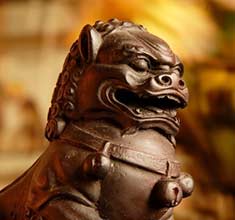
In all of these legends, the involvement of Buddha in the origins of the dog meant that the dog belonged in the temples of China. He was small enough to explore and ferret out any demons that might be in the temple, and he was so fierce from his lion ancestry that he could destroy even the largest of demons.
What does a Peke look like?
Originally bred with a spaniel-type coat, the Pekingese is usually shown today with a long-haired coat in just about any color combination. The majority of Pekes are either gold, red, or sable, but the breed standard allows for light gold, cream, black, white, sable, blue, or black and tan.
The dogs weigh from 7 – 14 pounds and stand about 6 – 9 inches tall. Dogs over 14 pounds are disqualified from the show ring. Smaller Pekingese may be called sleeve Pekingese or “sleeves” because Chinese emperors used to carry the smallest dogs in the sleeves of their robes.
The head of a Pekingese is very large in proportion to his body. The massive topskull is flat with wide set, bold eyes and a broad lower jaw. The face is flat and slants back slightly from the chin to the forehead. Ears are heart-shaped and lie flat against the head. The broad, short nose is black with wide open nostrils. A hair-covered fold of skin, known as the wrinkle, separates the upper and lower areas of the face. The wrinkle goes across both cheeks, ending in a slight V over the bridge of the nose.
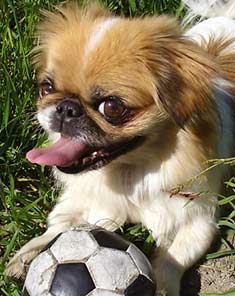
The Peke body is pear-shaped and low to the ground, with a high tail arched over the back. The forelegs are slightly bowed, with the front feet turned slightly outwards. The rear legs are straighter and the back feet point straight ahead.
The Pekingese has a double coat, composed of a long, straight top coat and a thick, soft undercoat. There is a mane around the neck and shoulders, giving the dog its nickname of “lion dog”.
How do I care for my Pekingese?
A healthy Pekingese coat requires daily brushing and visits to a groomer about once every three months. This keeps the coat clean while preventing tangles. If you do not intend to show your Peke, there is no need to mess with the longer coat, as you can just have the groomer cut him in an easy to care for, all-over short style known as a puppy cut. Diligence in grooming will help to control the moderate shedding associated with these hairy dogs.
Daily face washing is important. You must clean out the corners of your Peke’s eyes and along the facial wrinkle to prevent the formation of hotspots. These painful sores can form in a hurry and are sometimes difficult to clear up, particularly on the face.
What can I expect from my Peke?
These stubborn, jealous dogs usually become attached to one person, towards whom they will be both loyal and protective. The Pekingese is not generally great with children or other animals, but he can be socialized to accept them. Care should be taken with any Pekingese, as they have been known to bite both other animals and people.
Pekes are notoriously hard to train, not because they are dumb, but because they don’t see the benefit of training. They learn best from positive training methods, whereby they are induced to perform because they associate good performance with attention and treats.
Are there any health problems associated with the Pekingese?
Because of their small size, you must take some care in handling your Pekingese. Although they are not fragile, like most toy breeds they cannot tolerate overly rough play. Their long bodies and short legs make them susceptible to slipped discs and dislocated kneecaps, so they should be discouraged from jumping up on furniture. Cumulative damage from rough play or jumping up and down can lead to bone and joint problems including arthritis. When you pick up your Peke, make sure to hold him both at his chest and his belly, providing support for the entire length of his spine.
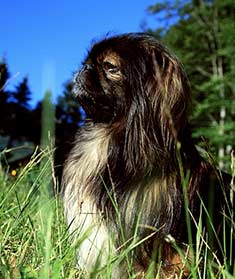
The breed is relatively low energy, so they don’t need daily Frisbee games on the beach or frequent romps at the dog park. Short walks around the neighborhood should suffice for exercise, keeping your dog trim enough to prevent joint problems.
Like other brachycephalic breeds, the Pekingese can have trouble breathing. The wide head and flat nose of these breeds restricts their respiratory effort, giving them low endurance for exercise. If you notice your dog panting and wheezing, it means he needs a break.
It is important to provide adequate shade and water for your Pekingese. Because they often have trouble breathing and because they have so much fur, it is quite easy for them to overheat. They should not be left outside on hot days, and must have access to a cool part of your home if you don’t have central air conditioning. Heat stroke is a medical emergency as it can quickly result in death. If your dog has been outside in the heat and begins to look fatigued or disoriented, you must get him to a vet immediately.
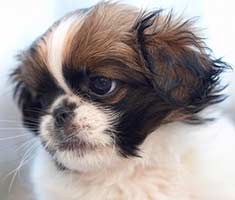
Like many smaller breeds of dog, the Pekingese can suffer from congestive heart failure. If the heart muscle becomes weakened due to high blood pressure or leaky valves, the animal’s blood will back up into the lungs. The dog will become less active and have difficulty breathing as the disease progresses. Due to the lack of oxygen, the membranes in his mouth can become grey rather than their usual pink.
Recommended Homes for the Pekingese
If you live in a smaller home or can’t get out to exercise a large dog, the Pekingese may be just what you are looking for, particularly if you don’t have small children or other animals. Just make sure you are willing to commit to the time required for grooming and maintaining the health of our dog before you decide to adopt a Peke.
Doggies Den: Latest Articles
 Homemade Thanksgiving Treats for Your Dog
Homemade Thanksgiving Treats for Your Dog
NUTRITION We all want to include our dogs in our holiday celebrations, but hopefully, you're aware that sharing table scraps with your dog isn't always the best idea.
 Keeping Your Dog Safe during the Summer Months
Keeping Your Dog Safe during the Summer Months
HEALTH Summer is coming on fast, so it’s time to plan how you will keep your dog safe and healthy through the lazy, carefree, warm days.
 Vaccination Time Again-Keeping Your Puppy Healthy
Vaccination Time Again-Keeping Your Puppy Healthy
DOG HEALTH So you have your new puppy picked out. There are quite a few shots, treatments and examinations that will keep the newest member of your family healthy.
 Canine Thanksgiving Feast
Canine Thanksgiving Feast
NUTRITION With the wide variety of food at Thanksgiving dinner, chances are you'll want to give your dog something special, too. If you're contemplating what to feed your dog for the holiday, here is a guide to a great Canine Thanksgiving Feast.
 Dog Walking Tips Every Owner Should Know
Dog Walking Tips Every Owner Should Know
DOG FUN Walking your dog is not only crucial to keeping him healthy and happy, it strengthens the bond between your canine friend and his caregiver. There are a lot of obstacles out there. Don’t forget these simple tips to keep your walk fun and safe in the outside world.
 The Benefits of Physiotherapy for your Dog
The Benefits of Physiotherapy for your Dog
HEALTH The same techniques that physiotherapists use to treat a variety of injuries and conditions in humans have been adapted to suit animals with great success. Family pets, show dogs, and working dogs can all benefit greatly from physiotherapy. Dogs whose activities involve a lot of agility are especially susceptible to the types of problems that physiotherapy can address.
 The Decision- Adding a Dog to Your Family
The Decision- Adding a Dog to Your Family
FIRST TIME OWNERSBringing a dog into your family is a decision where many people don’t realize it’s magnitude until after they have the dog. There are a number of things that you need to research before you decide to purchase a dog, and it starts right in your own home.
 Bringing Your Dog Into Your New Baby's Life
Bringing Your Dog Into Your New Baby's Life
HEALTH Many believe that a dog and a new baby cannot happily coexist, so therefore the dog has to go. This is not necessarily the case.  A new baby does not mean you have to abandon your dog.

Doggies Den:
Most Popular Articles

Dog Pregnancy Symptoms
HEALTHIf you suspect your dog might be pregnant, check out part one in this series on pregnant dogs, where we cover pregnant dog symptoms.
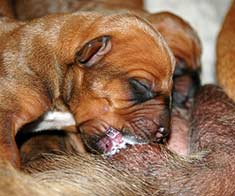
Dog Birth
HEALTHIn the third article of our dog pregnancy series, we look at the wonderful, but messy, process of bringing newborn puppies into the world.

Indoor Dog Potties
DOG PRODUCTSIt's been a long day at work. You were so busy, you didn't even take time to eat a sandwich, let alone run home to let your dog out. You're on your way home, knowing the poor dog is crossing his or her legs by now, when your car breaks down, delaying you even further. Can't somebody make this easier?
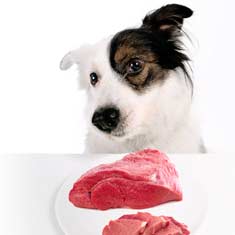
Your Dog’s Digestive System
PHYSIOLOGYEver wonder why your dog eats so fast? Or why he eats gross things? Or why he gets sick to his stomach? Or why his waste stinks so bad? Some of these things are normal, some are not.

Canine Respiratory System
BREATHINGThe basic function of your dog's respiratory system is to bring oxygen in to and remove carbon dioxide from the body. Knowing the symptoms of respiratory diseases can help you help your stay healthy.
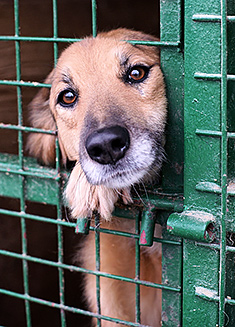
Shelter Dog Adoption Tips for Success
ADOPTION Are you intimidated by the prospect of "rescuing" a dog from a shelter? One reason that you may be wary of adopting a dog from a shelter is not knowing how to choose. Adopting a dog from a shelter can be a rewarding process, if you're prepared to do a reasonable amount of research.

Canine Urinary Tract Infections
SYMPTOMS AND TREATMENTDoes your dog seem to be having trouble relieving his or her bladder? Learn how to recognize the signs of urinary tract infections and how to treat them before they spread.

What to do for Dog Diarrhea
SYMPTOMS AND REMEDIESIf you have dogs in your house for any length of time, you have likely experienced at least one bout of dog diarrhea. Beyond the pain in the tuckus involved in cleaning up the mess, you should know what causes diarrhea, and when it's important to see the vet.
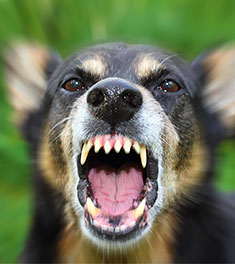
What to do for a Dog Bite
DOG BEHAVIOR Getting bitten by a dog can be scary, and you may be tempted to run around in circles for a while, trying to figure out what to do. Here's our guide to help you manage the situation.

Top Ten Tips for Living with a Senior Dog
DOG HEALTH Bringing home a new puppy is so exciting, but it doesn’t take all that long for your exuberant puppy to grow into a senior dog who may have special needs. Here are the doggies.com top ten tips for taking care of your companion who has been with you through so much.
